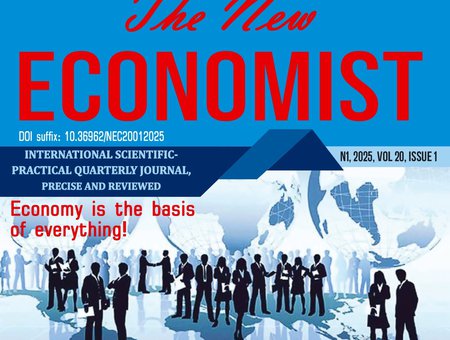Issues With Financing Innovative Activities

Lamara Qoqiauri
Doctor of Economic Science, Professor Leading Scientific Worker of the National Innovative Research Institute
Abstract
The creative evolution of a society (or a nation) is an ongoing activity in the twenty-first century. The best possible financing sources and policy implementation are critical to the success of developing, implementing, and sharing innovations. Therefore, the state's role in regulating, promoting, and coordinating creative science and technology is strengthened when innovative activities are properly organized and funded in an objective manner. The availability of funding sources for creative endeavors and the hazards involved will be the main topics of this essay.
The essay emphasizes the fundamentals of innovation finance in order to solve the issues brought up in the areas of innovation and funding inventive activities. Own money, foreign investments, venture capital, equity financing, private charity gifts, so-called business angel’s funds, borrowed funds, forfaiting, factoring, and other sources are among the primary sources that are examined and generalized. The article thoroughly discusses the needs, limits, benefits, and drawbacks of the sources listed, based on the study, comparison, and SWOT analysis of those sources.
In the work a great attention was paid to foreign investments as one of the important sources of innovative business financing. Attracting foreign investments in national economics for financing innovative programmes faces a number of challenges that is caused by low financial international rate; as well as by instability of a country’s important political, economic and innovative legislative base.
The article gives some modest recommendations in implementing the main forms of foreign capital in innovative sphere, namely, according to the author’s opinion, the following forms of investments should be paid more attention in national economics:
- Investments in the form of state loan, formed in the form of state debt, bonds of the foreign states and international financial institutions;
- Investments in the form of the share in the share capital of the local organizations;
- Investments in the form of investments in securities, including in the form of state, corporations and institutional issuers;
- Foreign credits;
- Licensed credits providing national economy (organizations), through relatively modern technique and technologies;
- Financial credits in the local organizations;
- Favorable conditions for entering knowledge-intensive technologies.
Consequently, a number of suggestions and recommendations are made for the creation of a successful system for funding inventions and creative endeavors.
References
- Abralava A., 2014, Global and Innovative Problems of Economy and Business. Monograph. Universali. P. 311 (in Georgian)
- Anshin V. M., Filin S.A., 2003. Management of Investments and Innovations in Small and Venture Business – M.: ANKIL.
- Chiqava L., 2006. Innovative Economy. Tb.; Siakhle Publishing House (in Georgian)
- Davtian M., Sherbakova T., Karzanova I. 2014. Economics of innovative activity. M. p 430.
- Drucker Peter Ferdinand 2007. Innovation and Entrepreneurship. Practice and Principles. First edition 1985. Published by Elsevier ltd. Routledge. 253 p.
- Etzkowitz H., 2008. The Triple Helix: University-Industry-Government. Innovationin Action. Routledge, p. 180.
- Golichenko O. G., 2011. Basic Factors for Development of the National Innovation Sistem. Moscow: Nauka. (In Russian).
- Gorfinkel V. Y., 2013. Innovational Management / under the editorship of V. Y. Gorfinkel, T. G. Popadyuk. – M.: UNITY.
- Iakovets. I. 2004. Epoch Innovations of the XXI century. M.: Publishing house: “Economics’’.
- International Management / under the editorship of S. E. Pivovarov, D. I. Barkan, L. S. Tarasevich, A. I. Maysel., 2000. SPB.: Piter.
- Jonson D., 1998. Innovations. Trans. From English. M.: Mir. p. 14.
- Kadochnikov S. M., 2002. Direct Foreign Investments of Modern Theory of Institutional Economy and the Theory of International Trade. SPB.: September, 128 p. (in Russian).
- Khargadon E., 2007. Management of Innovations. Experience of Leading Companies. M.: Williams.
- Kim W. C., Mauborgne R., 1999. Straregy, Value Innovation and the Knowledge Economy // Sloan management review. Spring. p. 46.
- Kravets A. V., 2016. Innovation Economy: Problems and Prospects of Economic Growth // KreativnayaEkonomika. – Vol. 10 – No. 1 p. 21-34. doi: 10.18334/ce.10.1.2233 (in Russian).
- Lenchuk V., Vlaskin G. 2009. Investment aspects of innovative growth: world experience. M. : Liborokom p.64.
- Leydesdorff L., 2012. The Triple Helix of University-Industy-Government Relations/in E. Carayannis, D Campbell (eds.). Encyclopedia of Creativity, Innovation, and Entrepreneurship, NeW - York: Springer, February.
- Lundvall B.A, 1992. National Systems of innovation: Towards a Theory of innovation learning London: Printer Publishers, National Innovation Systems; A. Comparative Analysis / R/ Nelson (cd) oxford; Oxford Univ. Press. 1993.
- Mazukato M., 2016. Only State Can Develop Innovations and Technologies effectively. www.BFM.ge European.ge.
20. Metcalfe S. 1995. The Economic Foundations of Technology Policy: Equilibrium and Evolutionary Perspectives/ed. bv P. Stoneman // Handbook of the Economics of Innovation and Technological
21. Nelson R. 1993. National Innovation Systems. A Comparative Analysis. N. Y.; Oxford: Oxford Univ. Press.
22. Porter M., Bjnd G., 1999. Innovative Capacity and Prosperity the Next Competitivenes challenge in the Glabal Competition venes Report. N.Y. p.12.
23. Qoqiauri L. 2016 For Further perfecting of Innovation Policy in Georgia. International Journal of latest research in Science and Technology. (IJLRST). Volume 5. Issue 3. P 11-21.
24. Qoqiauri L. 2017. Conceptual Basis of Conseption of National Innovative System// Vol. 4. Ussie 3. p. 10 - 26.
25. Qoqiauri L. 2017. From the History of Forming and Developing the Concept of the National Innovative System. Asian Development Policy Review (AESS). Vol.5., No 4. p. 272 - 280.
26. Qoqiauri L. 2017. Principles of Venture and Business - Angel Investments. Azian Economic and Financial Review. Vol. p.21-29
27. Qoqiauri L. 2018. Teoretical Aspects of Innovative Economics. Black Sea. Vol. 24. Issie 03. p. 48 - 55.
28. Qoqiauri L., 2009. Investment Market: Essence, Formation, Development. Tb.: TSU. P. 210. 320 (in Georgian)
29. Qoqiauri L., 2017. Conceptual Fundamentals of the Concept of the National Innovative System // Innovative Economy and Management. No. IV. P. 3-21. 661 (in Georgian)
30. Qoqiauri L., Gechbaia B., 2018. Preferable Directions of State Innovative Policy in Georgia // Innovative economy. No. 1; p. 14-34 (in Georgian)
31. Qoqiauri L., Qoqiauri N. Gechbaia B., 2018. Innovative Economy. Tb. Kalmosani Publishing. P. 650 (in Georgian)
32. Qoqiauri L., Qoqiauri N., 2015. Innovations. Tb.: Kalmosani Publishing (in Georgian)
33. Qoqiauri L. 2020. Innovtive Management. (Manual), Tbilisi. Publishing House “Kalmosani”, p. 425.
34. Raizberg B.A., Lozovsky L.Sh., Starodubtseva E.B., 1999. Modern Economic Disctionary, 2nd editing, edited. M.: INFRA-M. p. 479.
35. Rucker P. F., 2008. The Discipline of Innovation //Harvard business review. 1998. Vol. 76. N6. p. 156.
36. Santo B., 1990. Innovation as the Means for Economic Development. – M.: Progress. P.123.
37. Schumpeter I.A., 1982. Theory of Economic Development. М.: Progress p. 81
38. Schumpeter J. A., 1961. Konjunkturzyklen. Bd, 1.Guttingen. p.95
39. Tchalaganidze Sh., 2000. Problems of Innovative Activities in Georgia. Tbilisi (in Georgian)
40. Wessner C. W. 2004. Entrepreneurship and the Innovation Ecosystem. Policy Lessons from the United States//The Papers on Entrepreneurship, Growth and Public Policy. Germany, p. 5.
The new Economist, No1, 2025, Vol. 20, Issue 1.

07/04/2025
Copyright (c) 2025 Lamara Qoqiauri

This work is licensed under a Creative Commons Attribution-NonCommercial-NoDerivatives 4.0 International License.
